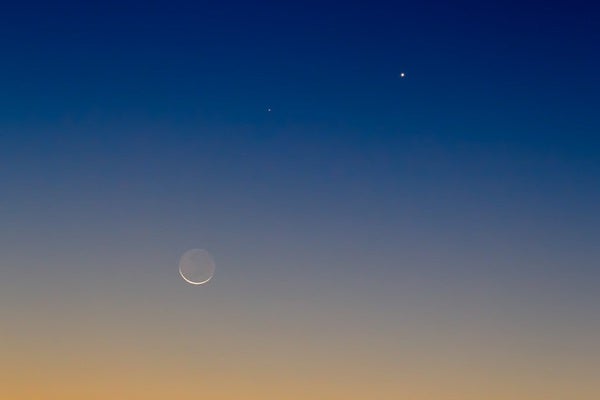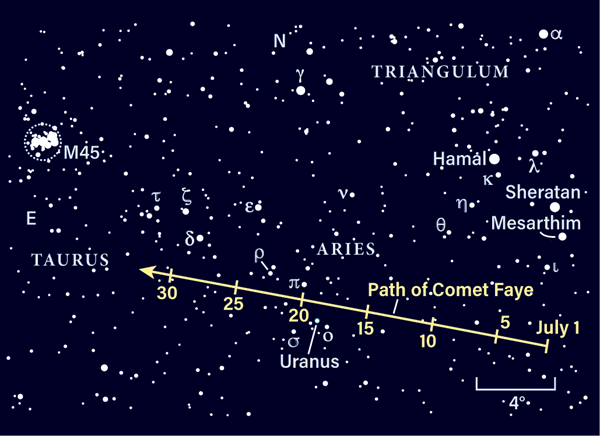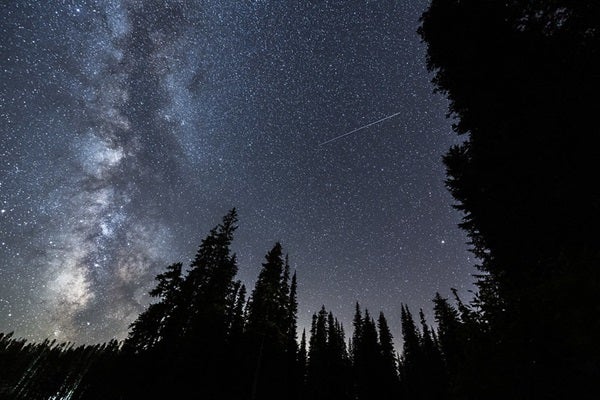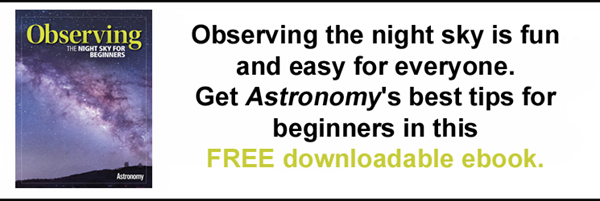Friday, July 9
New Moon occurs at 9:17 A.M. EDT. A moonless night is the best time to challenge yourself and your telescope, so tonight, set your sights on one of the most famous objects in the constellation Sagittarius: M20, the Trifid Nebula.
By two hours after sunset, the sky should be dark enough to begin your search. You’ll find M20 above the spout of the Teapot asterism, about 7.5° due north of 3rd-magnitude Alnasl (Gamma [γ] Sagittarii). The nebula is centered on the double star HN 40, whose components glow at magnitude 8 and 9. When observing this faint object, the size of your telescope will determine the amount of detail you can see. Mid-sized telescopes will show the Trifid as a hazy cloud surrounding the two stars; an aperture of 10 inches or more will begin to show the dark dust lanes that split the Trifid into the three lobes for which it is named.
There’s an added bonus nearby: Just 40′ northeast of the Trifid is M21, a magnitude 6.5 open cluster of young stars. This centrally concentrated grouping of stars spans about 13′ and is often visible alongside the Trifid at lower magnifications.
Sunrise: 5:40 A.M.
Sunset: 8:30 P.M.
Moonrise: 5:01 A.M.
Moonset: 8:41 P.M.
Moon Phase: New
*Times for sunrise, sunset, moonrise, and moonset are given in local time from 40° N 90° W. The Moon’s illumination is given at 12 P.M. local time from the same location.
Saturday, July 10
Saturn and its gorgeous rings rise just before 10 P.M. local time tonight. You’ll find the magnitude 0.2 planet in Capricornus the Sea Goat, nearly 2.5° west of Theta (θ) Capricorni.
Zoom in on the scene with a telescope and you’ll find that several of Saturn’s moons are visible to the planet’s south tonight, including Dione, Tethys, Enceladus, and Titan. The largest and brightest of the bunch, Titan also sits farthest away: It’s about 1.2′ southwest of Saturn shortly after they rise.
The planet’s disk now spans about 18″ and its rings measure 42″ across — nearly the same size as the disk of larger, closer Jupiter, which rises about an hour later and one constellation to the east, in Aquarius. Jupiter, blazing a brighter magnitude –2.7, rises with the dark shadow of Europa already nearly halfway across the disk and heading steadily for the western limb. Europa itself sits just east of the planet, and slips onto Jupiter’s face around 12:15 A.M. EDT on the 11th. Farther east lies Callisto, while Ganymede (closest) and Io (farthest) sit to Jupiter’s west.
Sunrise: 5:41 A.M.
Sunset: 8:30 P.M.
Moonrise: 5:56 A.M.
Moonset: 9:26 P.M.
Moon Phase: Waxing crescent (1%)
Sunday, July 11
Once you’ve finished chasing the giant planets into the early-morning sky, turn your gaze east to spot Comet 4P/Faye, currently sharing the constellation Aries with Uranus. Faye’s 10th-magnitude glow is easy to spot through a 4-inch scope from a dark location. Larger apertures may even show the comet’s small, stubby tail, which extends to the north.
Faye currently sits well below the two brightest stars in Aries; you’ll find it at roughly the height of magnitude 5.7 Mu (μ) Arietis, although the comet sits about 6.1° southwest of the star. Just over 5° east of Faye is magnitude 5.8 Uranus, easy to catch in binoculars or a small scope. The distant ice giant, which spans 4″, is less than 0.5° from Omicron (ο) Arietis, which shines at the same magnitude.
Faye will glide past Uranus from July 18–19, so you’ll want to return to this region then to catch the close pass.
Sunrise: 5:41 A.M.
Sunset: 8:30 P.M.
Moonrise: 6:58 A.M.
Moonset: 10:05 P.M.
Moon Phase: Waxing crescent (3%)
Monday, July 12
Tomorrow morning brings us a close conjunction of Venus and Mars. But first, the Moon mingles with our neighboring planets, as our satellite passes 3° north of Venus at 5 A.M. EDT and 4° north of Mars at 6 A.M. EDT. The trio isn’t visible then, but you can catch them in the west shortly after sunset. The planetary pair is now 7.3° west of the thin crescent Moon. Venus is magnitude –3.9 and lies due north (to the upper right) of Mars, which glows at magnitude 1.8 — 190x fainter than Venus.
All three lie in Leo the Lion, northwest of the big cat’s brightest star, Regulus. Mars and Venus are about 33′ apart. The moment the pair comes closest — 30′ or 0.5° — occurs early tomorrow morning at 3 A.M. EDT, when the planets are again invisible for U.S. observers. Tomorrow night, they’ll once more sit about 33′ apart, so if you aren’t able to catch them this evening, try again tomorrow for a similar view.
Mars reaches aphelion — the farthest point from the Sun in its orbit — tonight at 8 P.M. EDT. At that time, the Red Planet will sit 154.9 million miles (249.3 million kilometers) from the Sun.
Sunrise: 5:42 A.M.
Sunset: 8:29 P.M.
Moonrise: 8:03 A.M.
Moonset: 10:39 P.M.
Moon Phase: Waxing crescent (7%)
Tuesday, July 13
Venus passes 0.5° north of Mars at 3 A.M. EDT this morning in a close conjunction. But the pair isn’t visible at that time; you’ll instead want to catch them at sunset, when they’re about 33′ apart and about 11° high half an hour after the Sun disappears below the horizon. Venus will now appear directly above (northeast of) Mars, and both will be easy to spot with the naked eye as twilight descends. They’ll also be visible in any pair of binoculars or telescope with a field of view greater than about 0.5°.
The Moon, now a slightly larger crescent, is farther from the planets — 19° east — and closer to Leo’s hindquarters and tail, marked by a right triangle formed from the three stars Chertan, Zosma, and Denebola.
Sunrise: 5:43 A.M.
Sunset: 8:29 P.M.
Moonrise: 9:09 A.M.
Moonset: 11:10 P.M.
Moon Phase: Waxing crescent (14%)
Wednesday, July 14
Although it won’t peak until the end of the month, the Southern Delta Aquariid meteor shower is now slowly ramping up. Despite the shower’s low rates, you may begin seeing more than the average background level of few sporadic meteors per hour. Keep your eyes peeled for brighter shower meteors that may leave long trails as these tiny specs of interplanetary dust burn up brilliantly in our atmosphere.
The shower’s radiant is located 10° west of the 3rd-magnitude star Skat in Aquarius. It will be highest for Northern Hemisphere viewers early in the predawn sky to the south, floating above 1st-magnitude Fomalhaut in Piscis Austrinus. Also in Aquarius are bright Jupiter and distant Neptune, the latter of which requires binoculars or a telescope to spot its magnitude 7.7 glow.
As the month progresses and the shower’s strength increases, so too will the Moon’s disruptive presence in the sky. That’s why it’s somewhat more likely that you may spot a shower meteor earlier in the month, when rates are lower but the Moon is much less intrusive.
Sunrise: 5:44 A.M.
Sunset: 8:28 P.M.
Moonrise: 10:16 A.M.
Moonset: 11:37 P.M.
Moon Phase: Waxing crescent (22%)
Thursday, July 15
Early rises with a clear view of the eastern horizon may catch a glimpse of planet Mercury. Now magnitude –0.6, the tiny planet is nearly 3° high an hour before sunrise, sitting just 7′ west of magnitude 2.9 Tejat Posterior in Gemini the Twins. Mercury shows a 67-percent-lit disk that spans 6″.
The planet will continue to brighten but also sinks toward the Sun as time goes by and the planet approaches its superior conjunction next month.
While you’re enjoying the predawn sky, look to Gemini’s upper right to the rich region of Taurus the Bull, which hosts both the Hyades and Pleiades open star clusters. How long can you track these two groups of stars in the growing twilight? Also visible amid the Hyades is the Bull’s bright red eye, Aldebaran, whose glow may linger a bit longer in the brightening sky.
Sunrise: 5:44 A.M.
Sunset: 8:27 P.M.
Moonrise: 11:24 A.M.
Moonset: —
Moon Phase: Waxing crescent (31%)
Friday, July 16
By two hours after sunset, the sky is dark and it’s time to turn your binoculars or telescope to the south, where you’ll find the constellation Scorpius, with his bright red heart and winding tail. The Scorpion is also home to one of the nearest globular clusters to Earth: M4, which sits a mere 7,200 light-years away. Because of its close proximity, this richly populated cluster of more than 100,000 stars spans a whopping 36′ — slightly more than the Full Moon!
But that large diameter somewhat spreads out its magnitude 5.6 glow, making it a bit difficult to spot with the naked eye unless your viewing location is very dark. Additionally, M4 sits behind partially obscuring clouds of gas and dust, which dim and redden its appearance. You’ll find M4 about 1.3° west of bright Antares, the constellation’s well-known alpha star. Through smaller binoculars, M4 will appear like a fluffy cotton ball; larger binoculars or a small (4-inch) telescope will start to resolve myriad member stars.
Sunrise: 5:45 A.M.
Sunset: 8:27 P.M.
Moonrise: 12:32 P.M.
Moonset: 12:03 A.M.
Moon Phase: Waxing crescent (42%)













